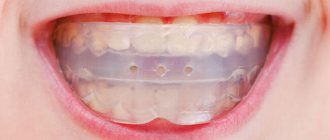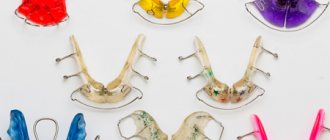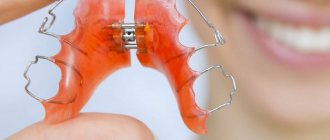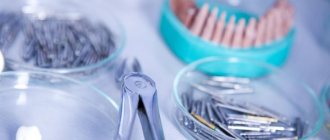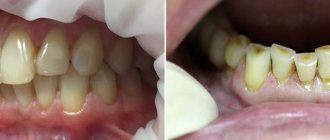Plates for teeth: removable and non-removable
In dentistry, doctors work with different types of orthodontic products. At the initial appointment, the orthodontist will tell the young patient and his parents what the plates for straightening teeth are called, how they differ and what they are like. The most popular:
- systems – single-jawed, with a retraction arch, with a pusher, with a hand-shaped process;
- devices – Brückle, Frenkel;
- Andresen-Goipl activator.
Products are divided according to the method of fixation:
- removable – hypoallergenic polymer construction includes wire hooks and arcs for fixing the plate;
- non-removable – they look like metal brackets that put pressure on the teeth from the outside, forming the correct bite.
A removable dental plate is placed on children to correct simple bite defects. The optimal age of a child for correction is 5-12 years. Fixed products can compete in effectiveness with braces; they are usually recommended for teenagers to eliminate serious anomalies of the dentition.
Braces are non-removable orthodontic structures in which a plate is placed on each tooth, and an arch with a “memory effect” is responsible for correcting the bite. Metal braces are the most effective, but sapphire and ceramic braces are almost invisible on the teeth. There are also ligature braces with rubber bands and self-ligating ones, which reduce the treatment period by several months.
Sizes and types. What are they made of?
Most plates are made either from food-safe plastic, which provides a rigid frame, or from soft silicone. The choice of material depends on the doctor's decision. Children's plates are made in two sizes:
- first (I) for children with primary malocclusion. Its radius is 22.5 mm. The product can be distinguished by the characteristic red color of the ring;
- the second (II) for children with mixed dentition. Its radius is 30 mm. She has a dark blue ring.
There are several varieties of vestibular plates . All of them appeared later than the standard one and, in addition to the development of nasal breathing, help to cope with the problems of a “flaccid” tongue, eliminate speech defects, correct swallowing, etc. The three most popular models are: classic, with a bead, with a flap and with a visor.
Model with visor
The visor appeared on vestibular orthodontic plates when doctors realized that it was difficult for children with underdeveloped jaws and protrusion of the upper frontal teeth to hold the classic model in their mouth. For them, it constantly deviated above the sagittal protrusion, and at night it completely fell out. The presence of a visor solves this problem.
The vestibular plate with a soft or hard visor is ideal for the treatment of all class II abnormalities. It also stops the development of class III anomalies if worn with the visor up. Due to the fact that the product pushes the upper jaw forward, wearing it normalizes the position of the jaws relative to each other.
Model with damper
The tongue deflector plate is designed for those children who are accustomed to placing their tongue between their teeth when swallowing and speaking. This habit interferes with the normal growth of teeth and leads to the formation of an “open” bite. The flap pushes the tongue back and forces it into the correct position.
In addition, a vestibular plate with a tongue flap helps:
- eliminate the habit of breathing through your mouth;
- teach the child to correctly position the tongue in the mouth during speech;
- strengthen the circular muscle of the tongue, normalize lip closure.
Because the model is often used with speech therapists to demonstrate proper tongue placement, it is made transparent.
Model with bead
The vestibular bead plate is used primarily to correct speech problems. It helps stimulate “flaccid tongue” in children with speech impediments. The standard plate itself aligns the position of the tongue, teeth, lips, helping to improve diction, and an additional design element enhances the effect.
There are two models of bead plate :
- classical. It has an extended bead that stimulates the root of the tongue. This model helps with dysarthria, increased muscle tone, impaired pronunciation of hard and soft consonants, rhinolalia, tachylalia, as well as in the treatment of stuttering. It helps to train weakened tongue muscles;
- new model. Her bead is moved closer to the plastic base and teeth. This model of plate is recommended for children with reduced tone of the tip of the tongue, various forms of sigmatism, lambdacism, and problems with the pronunciation of the “r” sound.
If for some reason a parent wants to buy a record without a doctor’s recommendation, it is advisable to purchase a standard model. It is universal, easy to use, and there is no negative effect when using it. All specialized models - with a bead, a visor, a flap - must be purchased exclusively on the recommendation of a doctor.
Does a plate straighten teeth: indications
Children are prescribed plates for the lower teeth and expansion plates for the upper and lower teeth only after a thorough diagnosis. Based on X-ray and panoramic photographs, measurements and study of proportions, the orthodontist decides to place a plate on the child’s teeth.
Treatment is indicated for:
- minor and serious anomalies of dental bite;
- violation of the tone of individual muscles;
- pathologies of tooth growth in the upper or lower jaws;
- incorrect position of incisors and canines;
- disproportionate growth and development of the dentofacial rows.
Orthodontic removable appliances equalize the growth rate of the jaw bones, straighten teeth in given planes, and correct the closure of the jaws.
What are orthodontic plates and what are they used for?
Orthodontic plates are removable devices for correcting occlusion defects, used at the stage of primary occlusion. They can be used on all primary teeth or during the period of mixed dentition, i.e. up to 12–13 years. With their help, you can quickly correct the location of your teeth and form the correct jaw size.
The classic version of the plate is of the following design:
- base made of elastic polymer or silicone;
- a metal arc that fixes the device on the teeth;
- elements that allow you to vary the size of the apparatus and, thereby, change the force of pressure on the dentition. Not all record models have them.
There are also vestibular models; they are used in children under 3 years of age. Visually resemble a pacifier:
What do children's dental plates look like?
A plate made in a pediatric dental laboratory is a standard of aesthetic perfection. Any shades, gradient colors, sparkles and bright decorations inside translucent plastic - children are delighted when they see it for the first time.
Structurally, the plate is:
- the base is strong and quite rigid;
- elastic wire - fasteners, arches and hooks are made from it, and it is this wire that provides the necessary pressure to correct the bite;
- the screw is an activator responsible for pressure and intensity of impact.
The screw is tightened by the doctor with a special key, or this is done by the parents according to the correction plan drawn up.
Soldatenkova Alina
I am often asked how dental plaques are made for children. First, we take impressions of the teeth – it doesn’t hurt, but sometimes it’s a little unpleasant. Then, based on the impressions, the appliance prescribed by the orthodontist is manufactured in a dental laboratory. Then try it on and create a design that is comfortable to wear. And issuing a plate to the patient with recommendations for wearing
Advantages and disadvantages
Vestibular plates are prescribed to children quite often because they are very effective and have almost no contraindications. The advantages of records are:
- ease of use and maintenance;
- need to be worn overnight and for several hours during the day (does not require use all the time like braces);
- low cost;
- training in a playful way;
- possibility of use from an early age;
- presence of other effects (strengthening speech organs, etc.)
The disadvantages include, first of all, a narrow range of influences. Plates cannot cope with all problems. Also, due to the ability to remove the product, the treatment time is extended.
How to wear dental plates - recommendations for children and parents
Whether dental plates help is the main concern of parents. Much depends on how correctly the young patient wears the orthodontic apparatus.
The main requirements for wearing orthodontic plates:
- duration – up to 20-22 hours daily;
- care - morning and evening cleansing with pastes, gels, weekly deep cleansing in a special solution;
- remove the product when eating;
- Do not play with the orthodontic appliance - remove it and return it to its place in the mouth with your tongue.
The doctor will show you how to put the plate on your teeth at your appointment, but there is nothing complicated about it. Metal arches fix the structure, and the regulatory elements are responsible for gentle correction of the bite while wearing.
It happens that a child takes the product out of his mouth, and then cannot figure out how to put the plate on his teeth - it either falls off or does not fit into place. Such a circumstance may be preceded by the following events:
- the device was in the mouth for less than 12-14 hours a day, and the fixation was broken;
- supporting units have been removed or fallen out – the structure requires orthodontic correction;
- a tooth erupts under the polymer part of the system and prevents it from taking the correct position;
- the plate was not worn for several days in a row - the bite has returned to its original position and you need to see a doctor to adjust the device;
- violation of medical recommendations for wearing removable plates - it is worth coming to an appointment and checking the condition of the product.
Plate care
Plates for teeth straightening, unlike braces, do not require special care. You don't need to buy any special tools for them. It is enough to remove such a structure during cleaning and also clean it separately. To do this, you can use a regular toothbrush and toothpaste. It is important to do this carefully so as not to damage the parts or change the tension of the screw.
If the patient wears a permanent structure, it should also be cleaned during oral hygiene. You can also use an additional rinse to get rid of bacteria in the spaces between the plate and the teeth.
To extend the life of the structure, it is not recommended to eat too hard foods, such as nuts, without first removing the structure from your mouth. It is also better not to drink very hot drinks or eat sweets with dyes. In this case, stains may appear on the dental plate.
Until what age can teeth be straightened with a plate?
Until what age do plates be placed on teeth is a question to be decided on an individual basis. Some devices work best during the period of active changes in occlusion, so they are recommended to be worn until 10-11 years of age. Other products perform well until the teeth completely change - up to 12-14 years. But the doctor assesses the situation more fully.
Often, orthodontists use a combined treatment method - changing devices, selecting new ones for the current situation. That is why it is not always necessary to delve into the names of plates for straightening teeth. The result is important, not what the dental plates are called.
It is difficult to answer how long a plate is worn on the teeth. Some patients require full-time braces and additional treatment with braces at age 14. For others, the situation improves in 1-2 years.
During an orthodontic consultation at Aza&Buka, patients will receive complete information about the treatment. The doctor will not just show a photo of an orthodontic children’s dental plate, but will also conduct an initial diagnosis, tell you the features of the planned correction, the approximate duration of treatment, and prospects. While the adults are talking, children can get acquainted with the variety of orthodontic devices - choose the color of the plate for the teeth and the design.
Indications for use
It is recommended to install leveling devices in order to:
- adjust the width of the sky;
- prevent further displacement;
- change the shape of the jaw bones;
- keep the units in the correct position;
- stimulate or, conversely, stop jaw growth.
You can understand that there are orthodontic problems by the following signs:
- molars, incisors or canines are crooked, located at an incorrect angle, protrude in front of their neighbors or are located behind them;
- the lower jaw protrudes strongly forward;
- rows do not close correctly;
- the upper lip protrudes.
Why wear orthodontic plates to correct your bite?
Using dental devices, you can achieve the following results:
- make the row even, harmonious, improve the appearance of the smile;
- eliminate pain that occurs when chewing solid food due to improper positioning of the jaws;
- change the tilt or rotation of specific units;
- improve diction, remove lisp, burr;
- reduce interdental gaps.
Most often, bite correction with plates is prescribed to children of preschool and adolescence, that is, patients of those age groups whose jaws are not yet fully formed and therefore respond well to external influences. But this does not mean that adults cannot resort to the help of records. If the defect is minor, it is quite possible to eliminate it without braces, even in adulthood.
Plates or braces – what to choose for your child?
There shouldn't be such a choice at all. These types of orthodontic appliances have different functions and capabilities. If the plates affect all teeth in a row, then braces successfully solve isolated problems, remove severe curvatures of individual units, crowding, and severe malocclusions. Also, the plate cannot be used if traumatic periodontitis is diagnosed. It should be noted that today orthodontists successfully combine these methods of treating dental anomalies. So, first they can prescribe the child to wear a braces system, and when the defect becomes less noticeable - plates.
